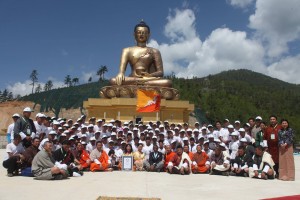
On June 2, Bhutan set its very first Guinness World record.
A hundred volunteers, in just one hour, planted 49,672 saplings to break the previous record held by the state of Assam in India. Three years ago, they had planted 40,885 saplings. The record attempt was actually set at 50,000 but 328 of the saplings did not meet the standards set by Guinness World Record officials.
Her Majesty the Queen Mother Dorji Wangmo Wangchuck, the guest of honor at the event, uplifted the volunteers before the start of the record attempt. She later applauded them on their success and said the record was befitting as the very first endeavor for a world record was for enhancing the environment. Bhutan, a nation governed by Gross National Happiness (GNH), has vowed to keep 60% of the country under forest cover.

In the last two decades, forest coverage in the country has increased to about 80 percent from 72 percent in the 1990s, according to forestry department records. And, of the 80 percent, about 10 percent is made up of shrubs, while the rest is covered by trees.
To maintain forest coverage of 80 percent, tree plantations are carried out regularly in all the districts through the dzongkhag forest sectors and forests territorial divisions. In case of felling of trees for timber, reforestation of the same species is done.
The forest plantation record dates back to the late 1940s when the first plantation was carried out in Gelephu on a 3.20-acre of land. The annual tree planting activity was later re-enforced after June 2 was declared the Social Forestry Day in 1985 – to commemorate the coronation of His Majesty the Fourth Druk Gyalpo.
Now, to celebrate the beloved fourth King’s 60 birth anniversary, people from all walks of life volunteered to take up positions on the slopes of Kuenselphodrang in Thimphu – eagerly anticipating the flag-off. Once the clock struck 8, they began planting the saplings in earnest and maintained the same vigor and enthusiasm throughout the hour. Guinness World Record Adjudicator, Pravin Patel, said, the team had made good progress all through the one-hour period.
The Bhutanese Constitution mandates the country maintain a minimum of 60 percent forest coverage. The policy is to maintain soil and climatic equilibrium given the rugged mountainous terrain and topography of the country.
In Bhutan, broad-leaved forests at 62 percent dominates forest type followed by mixed conifer at about 23 percent and fir, chirpine and blue pine at about 7 percent, 4 percent and 3 percent respectively.

